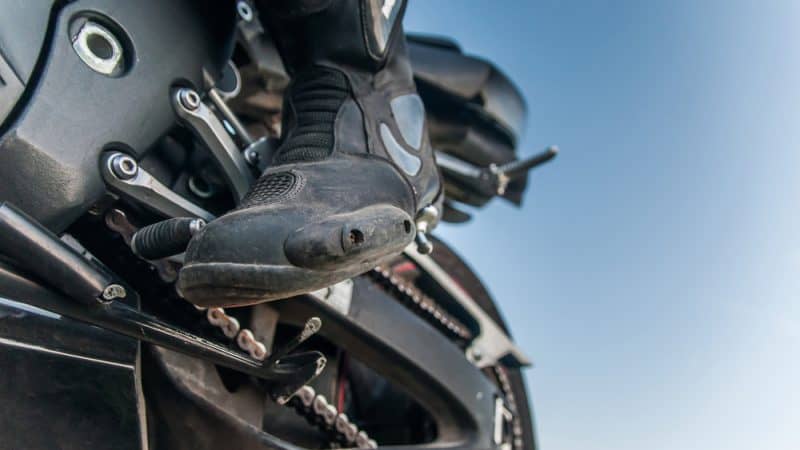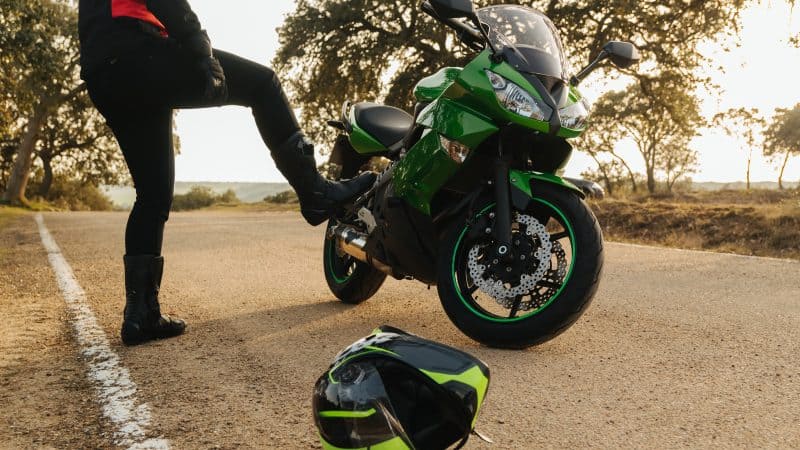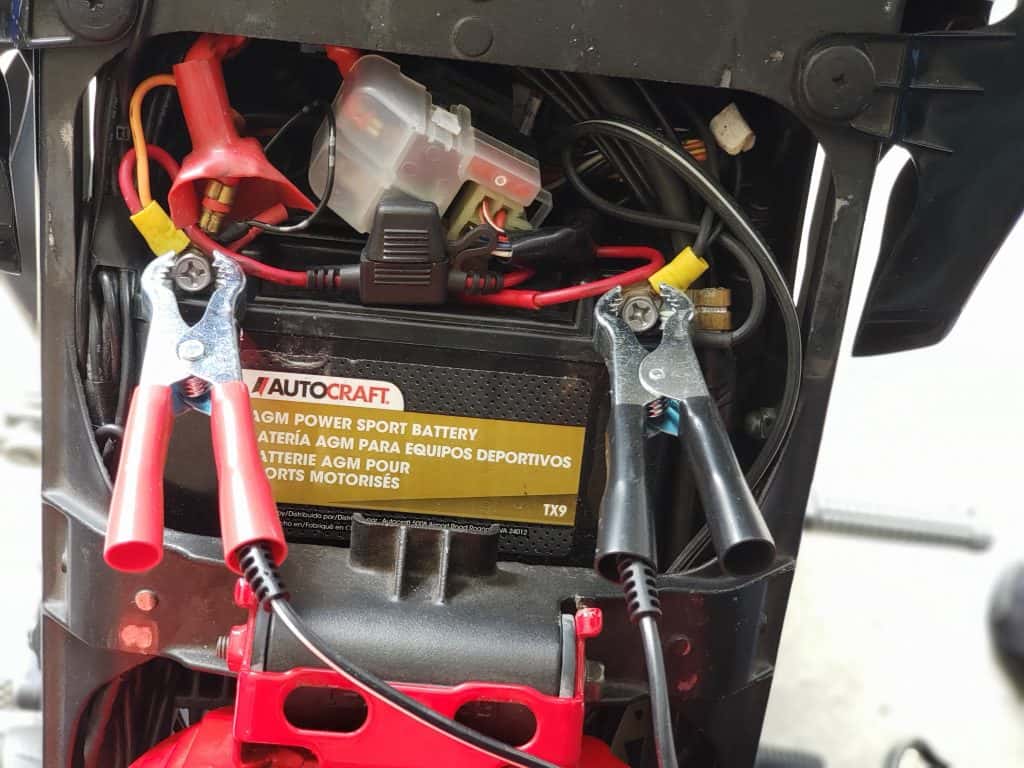Changing engine oil is essential to maintaining the life of your beloved motorcycle. If you don’t consistently check the oil level and change the oil when it gets old or dirty, the lifespan of the motor is severely shortened.
Let’s get started.
How Often You Need To Change Motorcycle Oil
Most riders will ask the question, “How often do I need to change the motorcycle engine oil?” at least once. The answer depends on the make/model of your bike (we’ll be discussed a Yamaha YZF-R6), the type of oil you used, and how often you ride.
If you used a mineral-based engine oil (the simplest, cheapest kind), then you should change the engine every 2,000 miles if you’re riding frequently. If you don’t ride regularly, you can change your oil at least twice a year.
When using a semi-synthetic engine oil, change the oil once every 5,000-6,000 miles.
Lastly, if you use a fully-synthetic engine oil, change the oil after 7,000-10,000 miles.
Semi- and fully-synthetic motor oils are more expensive than mineral-based engine oil, but the plus side is that they last much longer. The only time when you might have to change before the recommended mileage, regardless of the motor oil type, is if you are riding your bike every single day or you commute a great distance frequently.
Yamaha YZF-R6 Oil Change Instructions
You can find the following information in the owner’s manual of your Yamaha YZF-R6. If you don’t have this specific Yamaha model, it’s recommended you find the specific instructions for your make and model, as the steps could be different.
- Checking the engine oil level:
- Put the motorcycle on a level surface and hold it in an upright position, as straight as possible. Slight tilts could result in a false read.
- Start the engine. Let the oil warm up for several minutes.
- Turn the motorcycle off again.
- Wait for the oil to settle. This may take a few minutes.
- Remove the engine oil dipstick. Wipe it clean with a cloth then insert the stick back into the fuel reservoir. Take a moment to look at the maximum and minimum oil level lines before testing if you’re not familiar with it. Don’t screw the stick in. Remove it again to get your reading.
- If the engine oil level is at or below the minimum level, remove the engine filler cap and add a sufficient amount of oil to get the level to the recommended spot.
- Insert then tighten the engine oil dipstick. Afterwards, install and tighten the oil filler cap.
During this stage of your oil check, you might find that you need to change the oil completely.
How To Tell If You Need An Oil Change
The normal color of oil is transparent, brownish, maybe even slightly black. When oil is “clean,” it works best for protecting and keeping the engine clean.
Now, “dirty” oil is when the water consistency is lost. It feels slightly gritty when rubbed between your fingers. The color will be darker, if not completely black, and it will have lost it’s transparency.
You might also notice that the engine is making bizarre noises when the oil is dirty. All these signs point to needing an oil change.
How to change engine oil on a Yamaha YZF-R6:
- Put the motorcycle on a level surface.
- Removing the cowling.
- Start the engine for several minutes. Once warmed, turn the bike off.
- Place an oil pan under the engine to collect used oil.
- Remove the engine oil filler cap, the engine oil drain bolt, and lastly the gasket to drain the oil from the crankcase.
- Once the oil is drained completely, replace the gasket and bolt, fill the tank to the recommended level, and then replace the engine oil filler cap.
When To Change The Oil Filter
Change the filter every time you change the oil or once every 2,000 to 3,000 miles if you’re using synthetic motor oil. You don’t want to ride around with a dirty, old oil filter because it traps any dirt, dust, debris, metal, and sludge that would otherwise harm your engine.
Not a frequent rider? Again, change your oil at least twice a year and pair that with a filter change.
Conclusion
To wrap everything up, frequent riders will need to change their oil more often than those who ride once in a while. The quality of the motor oil changes the mileage for oil changes, and synthetic oils will have the longest life. Make sure to check the oil level and consistency often so you can protect the engine and preserve the life of your ride.
Enjoyed this information and want more? Head over to my YouTube channel. Subscribe and receive notifications for every update.
You Might also like
-
How to Choose the Right Motorcycle Jacket
The motorcycle jacket is one of the most iconic artifacts of biker culture, especially in public consciousness. When people picture a motorcyclist, they tend to envision someone clad in a well-made, well-fitted leather jacket.
With the continuous advancement of material sciences, the constant diversification of motorcycles themselves, and the rather varied climates of a global society, there are a plethora of jackets to choose from.
You’re bound to find the jacket that’s ideal for you, but there are a few variables to consider, such as what you find comfortable, the climates you’ll be riding in, and the type of motorcycle you’re going to use.
No products found.
The Four Motorcycle Jacket Styles
There are basically for style groups, when it comes to these jackets – Cruiser, Racing, Sport/Street and Adventure Touring/Dual Sport. Each of these has its own strengths, making them ideal for a specific riding style. Surprisingly, no single type of material/textile is standard for any given style of jacket either.
- Cruiser – This is the classic motorcycle jacket that most picture – the icon, the stereotype. While most commonly seen in leather, they’re also available in many other styles, with a focus on comfort and aesthetic. These are ideal for casual riders and those that use their motorcycle as transportation going about their daily lives.
- Racing – Racing jackets are distinctive for their tight fit and somewhat “space age” appearance. The tight fit is to prevent wind resistance, and the distinct appearance is due to flex panels designed to allow mobility while providing padding against abrasions from dangerous high-speed offs. They tend to have a narrower collar, and a zipper to fasten to racing pants (preventing ride up).
- Sport/Street – These jackets are a casual modification of racing jackets, taking the slower speeds into account. They’re distinguished by the less prominent flex panels and the looser fit focusing on comfort. Seasonal jackets of this sort also include insulation and ventilation to help keep the rider cool or warm in harsh conditions.
- Adventure/Dual Sport – This is a less common style of jacket, used primarily by those whom go on long rides across varied, often rough climates and terrains. They look like nothing more than a survival jacket imitating a racing jacket, with pockets for gear, layers of insulation and impact padding, and a form-hugging design with an additional fastening around the neck. These are ideal for winter riding, or those long trans-continental adventures.
No products found.
Important Motorcycle Jacket Factors To Consider
There are important factors to consider, which will determine the material you choose, and the style of jacket most suited to your needs.
- Leather or Textile – The first decision you’ll want to make is if you want leather or textile. Leather has a classic look, and many regard it as quite comfortable. However, its real strength is in its resistance to abrasion. However, for comfort and versatility in multiple climates and weather conditions, textiles tend to outperform it. This all comes down to whether you want comfort in various climates, or wish to focus on the durability of leather.
- Visibility/Reflectivity – While many would argue that subtlety is a sign of good everyday design, a jacket that catches the eye can actually be a major boon to safety. You want people to see you, and be aware of your presence and location on the road!
- Liners and Armor/Padding – If you ride in a temperate area with both hot and cold weather, you may want to look for a jacket with removable or all-weather lining that can help keep you warm in the winter, without the jacket cooking you in the summer. Similarly, even if you’re not a dare devil (and you shouldn’t be!), focusing on padding/armor around the chest, back and shoulders is also important, as these are areas where damage can be the worst if you have a nasty off.
- Fitment – Finally, you want a jacket that fits you well, and comfortably. It can be hard to find one that’s a perfect fit, but many styles of jacket have fitment adjustments on the waist and slides on the sleeves, which provide just the right amount of hug or slack for your personal comfort standards. You don’t want to wear a jacket that’s too tight or constrictive, cutting off circulation. The fatigue from this can lead to serious dangers.
To learn more about the different styles of jackets, which ones suit which styles of riding, and much more about the adventurous world of motorbiking, subscribe to my YouTube channel today!
No products found.
-
Beginner’s Guide To Shifting Gears On A Motorcycle
An underrated aspect of learning how to ride a motorcycle goes beyond turning and popping wheelies. No, it’s something seemingly much more simple than that. Do you shift? Sure, shifting gears should be easy, because it’s a basic function; but shifting gear does have a layer of complexity that beginning cyclists could have problems mastering right away.
Here’s everything you need to know about shifting gears on a motorcycle.Motorcycle Gears Basics
The three basic controls are ones that you might already know—the throttle, the clutch, and the gear selector. You use the throttle to rev the engine, the clutch to engage and disengage the brakes (transmission), and to select gears. For instance, if you pull the left hand clutch towards you, the engine revs without ever moving the bike.
The gear pattern can be clicked through by using the gear selector lever and is moved by your left foot. Most bikes have the following gears, starting with the lowest first:
• First gear
• Neutral
• Second gear
• Third gear
• Fourth gear
• Fifth gear
• Sixth gear (depending on the bike)
As you can see, shifting fears is sequential. Up or down, neutral (N) is always put between 1st and 2nd gear.Technique For Motorcycle Shifting
It’s best to learn the proper technique required to maneuver through shifting gears before learning how to do anything else.
Steps of the proper shifting technique:- Disengage the clutch. Use your left hand to pull it towards you.
- Select the correct gear by using your left food on the shifting lever.
- Slightly rev the engine if shifting up.
- Gradually release the clutch. Don’t pop it.
- Feather the throttle while releasing the clutch to accelerate smoothly.
- Continue revving if you which to switch to another gear in succession. Otherwise, find a nice cruising speed to maintain.
Shifting With Sound and Feel
Have you ever heard wailing motorcycle engines on the road? You’ve probably thought to yourself, “Is that rider even shifting?” That’s you using the basic rule of sound. In basic terms, if an engine starts to scream, you shift to an upper gear. If the engine starts to grumble, then shift the engine lower.
There a many methods to help you do this properly. Beginners should only focus on the simplest method. Afterwards, you can experiment.
Start off by riding in first gear. Try to sense to point when you need to switch to second gear. This means the engine isn’t yet screaming, but you are feeling the natural inclination to gain more speed. The clutch will disengage easily.
Should the engine start to scream, this means you’ve hit the red line, otherwise known as the built-in limiter. The limiter is placed in the engine to ensure the bike doesn’t overextend itself and burn up.
If you shift a gear up too soon, the bike could stall or choke. Restart the bike. Try again. Keep working through the gears until you can hear and feel when it is time to gear up.Shifting Smoothly
You will notice that there’s no mathematical equation to figure out the “when” behind shifting. Every bike has a unique behavior that depends on how you handle it. For instance, if the bike jerks when you release the clutch, you’re being too abrupt. If the bike tends to lurch during shifts, you’re applying too much throttle. If the motorcycle’s speed dips during shifting, you need to rev the engine more between gear changes. Pay attention to the clutch, throttle, and gear selector, because these all interact and are dependent on one another.
Mechanics of Movement
Let’s back-up for a moment. Now that you have this idea in your mind that you need to listen and feel and understand with muscle memory what to do when shifting, it’s time to talk about what is happening inside the bike while you’re doing the actions.
The clutch is the first thing you touch when it’s time to shift gears, unless you have an automatic motorcycle or a quick shift. Once the clutch is engaged, meaning the lever is out and power is send to the rear tie, little springs press on the clutch plate that connect the primary drive to the part that rotates from the pistons going up and down.
When you pull the lever, the plate separates and releases the connection to the motor. In this moment, you can change gears.
That’s when you take your foot and move the gear selector. On the gear selector is a piece called a collar that has “dogs.” This dogs mesh together with the fork in the same way you interlace your fingers. When you move your foot up and down on the selector, the dogs and fork connect to help change the gear. Then, you find the right gear and accelerate.
Keep this in mind while reading the next two sections about upshifting and downshifting.Upshifting
Most of this article has been devoted to upshifting. Upshifting is easier than downshifting, because you are accelerating. This means that if you do any of the steps of shifting a little too quick, there’s less of an impact. Of course, this could result in a sudden jolt of power to the rear wheel, causing the front tire to come off the ground.
(Note: You should only practice stunts in a controlled environment and when you have gained enough experience.)Downshifting
On the opposite end of upshifting is downshifting, which tends to go a little less smoothly. If you release the clutch too quickly while downshifting, the sudden downward change can cause the gear to slow down the rear tire, compressing the front end, and causing a lack of traction in the back end. You need to be able to control the release of the clutch.
Be careful when rounding corners and decreasing your gears for this reason. You don’t want to suddenly lose traction right when you need more grip on the asphalt. That could cause the bike to skid to the side.False Neutral
When downshifting, you could accidentally hit a false neutral. This can happen anywhere there shouldn’t be a neutral, including between 3rd and 4th or 4th and 5th and so on. This could happen if the dogs don’t connect with the fork when selecting gears. There is power loss to the rear wheel.
If you end up in a false neutral, pull on the clutch, and put the bike into a higher gear. You can prevent excessive damage to the bike. Be quick and make sure you move into the correct once you get out of false neutral.
With that, you should be able to master the basics of shifting. Practice the timing of the clutch release and working with the gear selector for a bit. You will soon be able to shift between gears like someone who has been riding for many years.
Liked this article and want more beginner motorcycle tips? Check out my YouTube channel and don’t forget to hit that subscribe button. -
How to Properly Maintain Your Sportbike
Understanding the Importance of Sportbike Maintenance
Owning a sportbike is an exciting and rewarding experience, but it also comes with responsibilities. Proper maintenance is essential to ensure the longevity and performance of your bike, and to keep you safe on the road. In this comprehensive guide, we’ll explore the key components of sportbike maintenance and provide tips and tricks for keeping your bike in top condition.
Download RunThaCity’s General Sportbike Maintenance Schedule
Regular Maintenance Schedules: The Key to a Long-Lasting Sportbike
Regular maintenance is key to keeping your sportbike running smoothly and avoiding costly repairs down the road. The recommended maintenance schedule will vary depending on the make and model of your bike, as well as your riding style. Make sure to consult your owner’s manual for specific maintenance recommendations, and keep a record of all services and repairs performed on your bike. It’s always a good idea to perform routine checks on your sportbike to catch any potential issues early on. This can include checking fluid levels, the condition of hoses and belts, and the general state of the bike’s components.
Engine Oil and Filter Changes
One of the most important components of sportbike maintenance is regular engine oil and filter changes. Engine oil keeps your engine lubricated and prevents wear and tear, while the oil filter removes impurities from the oil. Oil changes should be performed at the intervals specified in your owner’s manual, and you should always use high-quality, recommended engine oil and filters. Skipping oil changes or using low-quality oil can cause serious damage to your engine, reduce fuel efficiency, and negatively impact performance.
Air Filter Cleaning or Replacing
The air filter is responsible for removing dirt and debris from the air that enters the engine. Dirty air filters can cause poor engine performance, reduced fuel efficiency, and even engine damage. Clean or replace your air filter at the intervals specified in your owner’s manual, or more often if you frequently ride in dusty or dirty conditions. Cleaning or replacing the air filter is a simple and inexpensive process that can greatly improve the performance and longevity of your sportbike.
Brake System Maintenance
The brake system is one of the most critical components of your sportbike, and proper maintenance is essential for safety. Regular brake inspections should be performed, and brake pads should be replaced as soon as they show signs of wear. The brake fluid should also be checked and replaced at the intervals specified in your owner’s manual. Worn or contaminated brake fluid can cause braking problems, and can negatively impact the overall performance of your brake system.
Tires
Tires are the only point of contact between your sportbike and the road, and they play a crucial role in handling and safety. Regular tire inspections should be performed, and tires should be replaced as soon as they show signs of wear or damage. Make sure to check the tire pressure regularly, as underinflated tires can cause handling problems and reduce fuel efficiency. Tires should also be rotated regularly to ensure even wear and extend their lifespan.
Battery Maintenance
Sportbike batteries can be expensive to replace, and proper maintenance is essential to extend their lifespan. Regular battery inspections should be performed, and batteries should be charged regularly if they are not being used. Make sure to disconnect the battery before performing any maintenance on your bike to avoid electrical problems. A battery that is not properly maintained can fail unexpectedly, leaving you stranded on the road.
Chain Maintenance
The chain is an essential component of your sportbike’s drivetrain, and proper maintenance is essential for smooth and efficient operation. Regular chain inspections should be performed, and the chain should be lubricated at the intervals specified in your owner’s manual. Make sure to use continue high-quality chain lubricant, and avoid getting lubricant on the brakes or tires. A worn or poorly lubricated chain can cause performance problems and even cause damage to other components of the drivetrain.
Suspension Maintenance
The suspension system of a sportbike plays a critical role in handling, comfort, and safety. Regular suspension inspections should be performed, and components should be replaced as soon as they show signs of wear or damage. Make sure to check the suspension settings and adjust them as necessary to match your riding style and the conditions you’ll be riding in. A poorly maintained suspension system can cause handling problems, reduce comfort, and negatively impact your overall riding experience.
Electrical System Maintenance
The electrical system of your sportbike is responsible for powering all of the bike’s components and accessories. Regular electrical system inspections should be performed, and components should be replaced as soon as they show signs of wear or damage. Make sure to check the battery, charging system, and all electrical connections for any signs of corrosion or damage. A poorly maintained electrical system can cause performance problems, reduce reliability, and even leave you stranded on the road.
Body and Fairing Maintenance
The body and fairing of your sportbike not only protect you from the wind and debris but also give your bike its signature look. Regular body and fairing inspections should be performed, and components should be replaced as soon as they show signs of wear or damage. Make sure to wash your sportbike regularly, and use high-quality wax or polish to protect the paint and prevent fading. A poorly maintained body and fairing can reduce the overall value of your bike, and make it more vulnerable to damage from the elements.
Conclusion:
Owning a sportbike is an exciting and rewarding experience, but it also comes with responsibilities. Proper maintenance is essential to ensure the longevity and performance of your bike, and to keep you safe on the road. By following the tips and tricks outlined in this comprehensive guide, you can keep your sportbike running smoothly, avoid costly repairs, and ensure that your riding experience is as enjoyable and safe as possible. Whether you’re an experienced rider or a newcomer to the sport, taking the time to properly maintain your sportbike is a worthwhile investment in your enjoyment and safety on the road.











One comment on “How Often Do I Need To Change Motorcycle Engine Oil?”